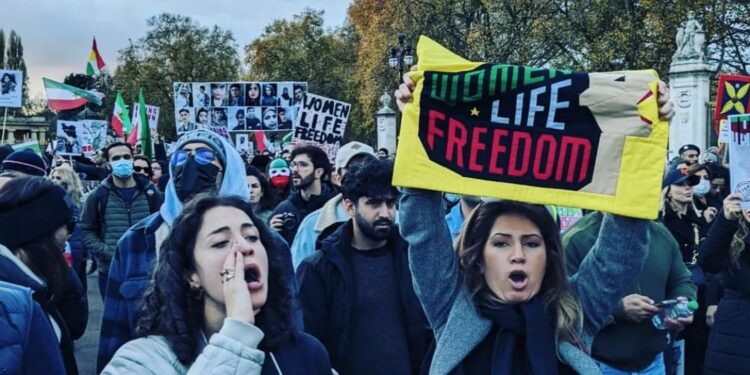Feminists have long argued that probably all modern states possess, albeit in different degrees, patriarchal tendencies. But patriarchy figures especially prominently in those authoritarian regimes and movements that exhibit conservative religious (Islamic, Christian, Jewish, or Hindu) dispositions. Indeed, patriarchy is entrenched in religious authoritarian polity.1 In many authoritarian Muslim states, such as Egypt, the Sudan, Saudi Arabia, or the Islamic Republic of Iran, where conservative Islamic laws are in place, women have become second-class citizens in many domains of public life.
Consequently, a central question for women’s rights activists is how to achieve gender equality under such circumstances. A commonly proposed strategy consists of organizing strong women’s movements to fight for equal rights. Movements are usually perceived in terms of collective and sustained activities of a large number of women organized under strong leaderships, with an effective network of solidarities, procedures of membership, mechanisms of framing, communication, and publicity—the types of social movements that are associated with images of marches, banners, organizations, lobbying, and the like.
It is a credit to women in most Western and democratic countries such as India for creating sustainable movements that have achieved remarkable outcomes since the 1960s. While it may be that many women in Muslim (and non-Muslim) authoritarian states do wish and indeed strive to build similar social movements, their struggles are often thwarted by the repressive measures of authoritarian/patriarchal states as well as the unsympathetic attitudes of many ordinary men.
Consequently, the type of collective actions practiced mostly in democratic settings, which have come to dominate our conceptual universe as the women’s movements, may not deliver under nondemocratic conditions, if they are ever allowed to emerge. The conventional social movement is concerned chiefly with politics of protest, contentious politics where collective actors exert pressure (by threat, disruption, or causing uncertainty) on adversaries to meet their demands. How do we account for a women’s activism that may rarely deploy organization and networking, mobilizing strategies, street marches, picketing, strikes, or disruption, and yet is able to extend their choices?
Imposing themselves as public players, women managed to make a significant shift in gender dynamics, empowering themselves in education, employment, and family law, while raising their self-esteem. They reinstated equal education with men, curtailed polygamy, restricted men’s right to divorce, demonized religiously sanctioned temporary marriage, reformed the marriage contract, improved the employment status of women, brought back women as judges, debated child custody, and to some degree changed gender attitudes in the family and in society. Women’s seemingly peculiar, dispersed, and daily struggles in the public domain not only changed aspects of their lives; they also advanced a more inclusive, egalitarian, and woman-centered interpretation of Islam.
Not only the Islamic republic, but many other Muslim societies have also experienced similar dispersed activities, albeit with varying effect, depending on the degree of misogyny of the states and the mobilizational efficacy of women. Nevertheless, because of their largely mundane and everyday nature, such women’s practices are hardly considered a particular type of activism that can lead to some far-reaching consequences.
Nevertheless, because of their largely mundane and everyday nature, such women’s practices are hardly considered a particular type of activism that can lead to some far-reaching consequences. How do we characterize such activities? How do we explain the logic of their operation?
From “Life as Politics: How Ordinary People Change the Middle East by Asef Bayat.”
Different from Western fantasies and against orientalism, Asif Bayat, in his book, focuses on the structural and historical aspects of Middle Eastern societies. These historical processes reveal the impact of post-colonial populism, global economic neoliberalism, authoritarian state structures, and family and neighborhood guardianship on the social life and political expression in the Middle East.
A book about struggles for social change in the Muslim Middle East, mostly focused on Iran and Egypt but with scattered references to other countries as well. The first edition was written not long before the Arab Spring and laid out an analysis that didn’t quite predict the uprising but that described dynamic circumstances allowing for its possibility in a way that most commentators in that moment failed to recognize. This edition was updated in 2013.
In retelling any history of revolutions, the uprisings that spread through the Middle East in 2011 will remain watershed events. These uprisings toppled longstanding dictators, overturned entrenched interests, and unsettled authoritarian regimes in a measure and magnitude that took everyone by surprise -policy makers, intelligence agents, scholars, and even the protagonists themselves. Yet these revolts did not emerge from a vacuum. They had their precursors- in structural changes reflected in urban growth, demographic shift s and growing disparity, the formation of new political actors, and in ongoing everyday struggles that all merged into these revolutionary moments. A new Middle East may now be on the horizon, a Middle East informed not only by the actions of the elites, military men, or foreign intrigues but a region influenced by the ordinary people. Change is no longer an elusive concept “alien” to the region, as the dominant narratives would have us believe; tyrannical rules do fall; and people do matter.
As Bayats’ work shows, ordinary people can change their societies through opportunities other than mass protests or revolutions; they can and do resort more widely to “non-movements”— the collective endeavors of millions of non-collective actors, carried out in the main squares, backstreets, court houses, and communities.










